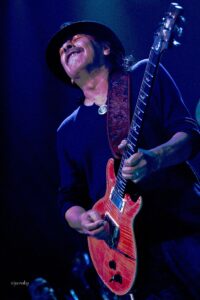 Carlos Augusto Alves Santana (born July 20, 1947) is a Mexican and American rock guitarist. He became famous in the late 1960s and early 1970s with his band, Santana, which pioneered rock, Latin music and jazz fusion. Santana continued to work in these forms over the following decades. He experienced a resurgence of popularity and critical acclaim in the late 1990s. In 2003, Rolling Stone magazine listed Santana at number 15 on their list of the 100 Greatest Guitarists of All Time. He has won 10 Grammy Awards and 3 Latin Grammy Awards.
Carlos Augusto Alves Santana (born July 20, 1947) is a Mexican and American rock guitarist. He became famous in the late 1960s and early 1970s with his band, Santana, which pioneered rock, Latin music and jazz fusion. Santana continued to work in these forms over the following decades. He experienced a resurgence of popularity and critical acclaim in the late 1990s. In 2003, Rolling Stone magazine listed Santana at number 15 on their list of the 100 Greatest Guitarists of All Time. He has won 10 Grammy Awards and 3 Latin Grammy Awards.
As far as Santana’s guitars and gear, it is somewhat hard to investigate the subject mainly for the fact that he never attaches himself to one particular guitar like some other guitarists do. In the late 60s he played mostly Gibson SG Specials with P90 pickups, and with the beginning of the 70s he migrated towards Les Pauls and more beefy humbucker sound. In mid 70s he had a short affair with a Gibson L6-S model, but soon switched to Yamaha SG2000 – which he helped design. In the early 80s he made a final switch to PRS guitars, and he’s been playing them exclusively to this day.
Yamaha SG-2000
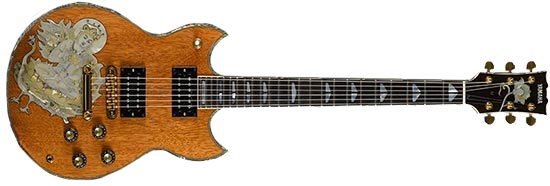
At the time Santana was playing the previously mention Gibson L6-S (circa 1975), Yamaha approached him with their new SG-175 model for a possible endorsement deal. Santana agreed to try out the guitar, and he ended up making a list of the things he didn’t like on it. He complained that the weight was too low and that the guitar needed to be heavier in order to get enough sustain. He also argue that a two-octave 24 fret neck was needed.
After the first prototype was made with the intention of addressing those issues, Santana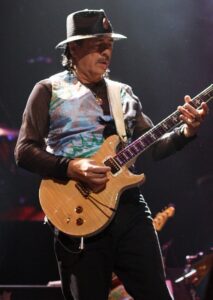 still didn’t fully like it. Yamaha went back to the drawing board, and with the Carlos’ help decided on a few more changes.
still didn’t fully like it. Yamaha went back to the drawing board, and with the Carlos’ help decided on a few more changes.
They went for neck-through-body design, meaning that the neck and the body are now actually glued together. They used what is now known as the T-Cross construction, where there are two pieces of mahogany surrounding the center maple part going thought the whole width of the guitar, with a piece of teak wood (maple was used on mass-produced model) on the top of the body. All the hardware was replaced with brass, and a sustain plate was installed to sit underneath the bridge. As for the electronics, two OPG-1 Alnico V pickups were used.
Santana used this guitar from around the time it was finished in early 1976, to around 1982 when he switched to PRS. His main guitar was the actual prototype which at the time it was made still didn’t have an official name – only in July 1976 Yamaha officially released the guitar as the SG2000. It featured dark natural finish, and custom Buddha headstock inlays, as well as body decals. His second most widely SG2000 was a black model featuring somewhat similar decals.
PRS
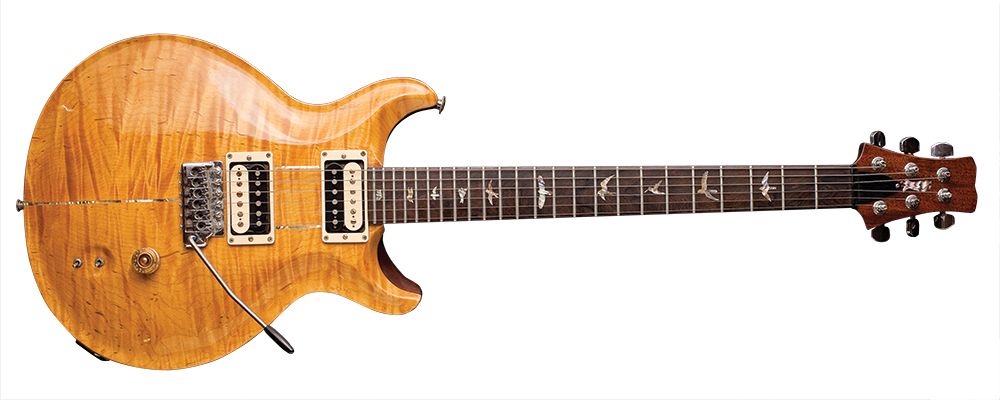
Ever since the early 1980s this has been Santana choice of guitars, and he’s been playing them almost exclusively. The person behind it all is Paul Reed Smith, who approached Santana at a concert in late 70s. Here is the video of Paul telling the story himself.
Few details that weren’t mentioned in the video – Paul said that the two met at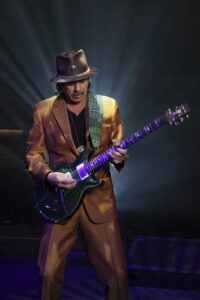 Merriweather Post Pavilion in Columbia, MD, around the time when Leon Chancler was playing drums for Santana. But going from the fact that the gig at Merriweather was played on 8/9/1980, and knowing that Leon left the band in 1976, drags some confusion into this story.
Merriweather Post Pavilion in Columbia, MD, around the time when Leon Chancler was playing drums for Santana. But going from the fact that the gig at Merriweather was played on 8/9/1980, and knowing that Leon left the band in 1976, drags some confusion into this story.
Next important thing is that we get an almost exact date when Santana started recording with PRS guitars – early 1981, or during the ‘Zebop!’ recording sessions. And lastly – we are introduced to the fact that the Washington gig on 4/21/1981 was the first concert that Santana ever played on a PRS guitar.
Now, lets actually focus on the guitar itself.
Several different models were made through the years, and most of the time Carlos does not stick to one guitar in particular. The mass-produced models include Santana I, Santana II, Santana III, Santana MD, Santana SE (Korean made), and the 25th Anniversary Santana model. The first ever PRS Santana I was made in 1995, which means that Paul made guitars for Carlos for 15 years before they actually decided to make a signature line.
The pickups used on all Santana models are designed by PRS, and in the beggining they were mostly all without the pickup covers with zebra patterns on the Santana I, but since Santana II and III they mostly feature metal covers. The body shape was designed by Paul himself as a sort of a crossover between a Stratocaster and a double-cut Les Paul Junior, and it is built using mahogany as a base, and specially selected maple wood as the top. The neck features 24.5″ scale length and 24 frets. The fretboard was Indian rosewood on the Santana I model, while the later ones feature Brazilian rosewood.
As said, it’s pointless trying to single out one guitar out of the all PRS guitars that went through Santana’s hands, since he’s kind of a person who doesn’t really stick to one guitar in particular.
His guitar tech Ed Adair speaks of a guitar nicknamed “Salmon”, which is a sort of Santana’s number one PRS, but most of the time Paul just makes a new guitar, and it gets sent to Carlos. If he ends up liking it (which he almost always does according to Paul), it becomes a part of his arsenal, and he takes it on tour. He talks very highly of Paul Reed Smith, and he trusts his skills and judgments when it comes to taking care of his guitars.
BELOW A REVIEW OF THE PRS SANTANA REPLICA
8.5 Score
Pros
- pleasantly surprised by both sound and playability
- a functional, ergonomic and versatile guitar
- smooth, fat and clear sound
- very good tuning stability
Cons
- neck glued under the neck pickup
- classic handle, slightly too big
- frets are slightly lower in height
- Speaking of backplates, it would have been better, as on the original Santana guitars, to have eliminated the vibrato back cover altogether.
Final Verdict
This third non-limited SE Santana model is not only a step forward from PRS's past history, but is perhaps the closest PRS has dared to replicate its US formula at a lower price point so far. It's not the real Santana model but a replica, but for many players it will be fine: a functional, ergonomic, versatile, perfectly weighted and easily customizable guitar, for those who love not only Santana's sound.


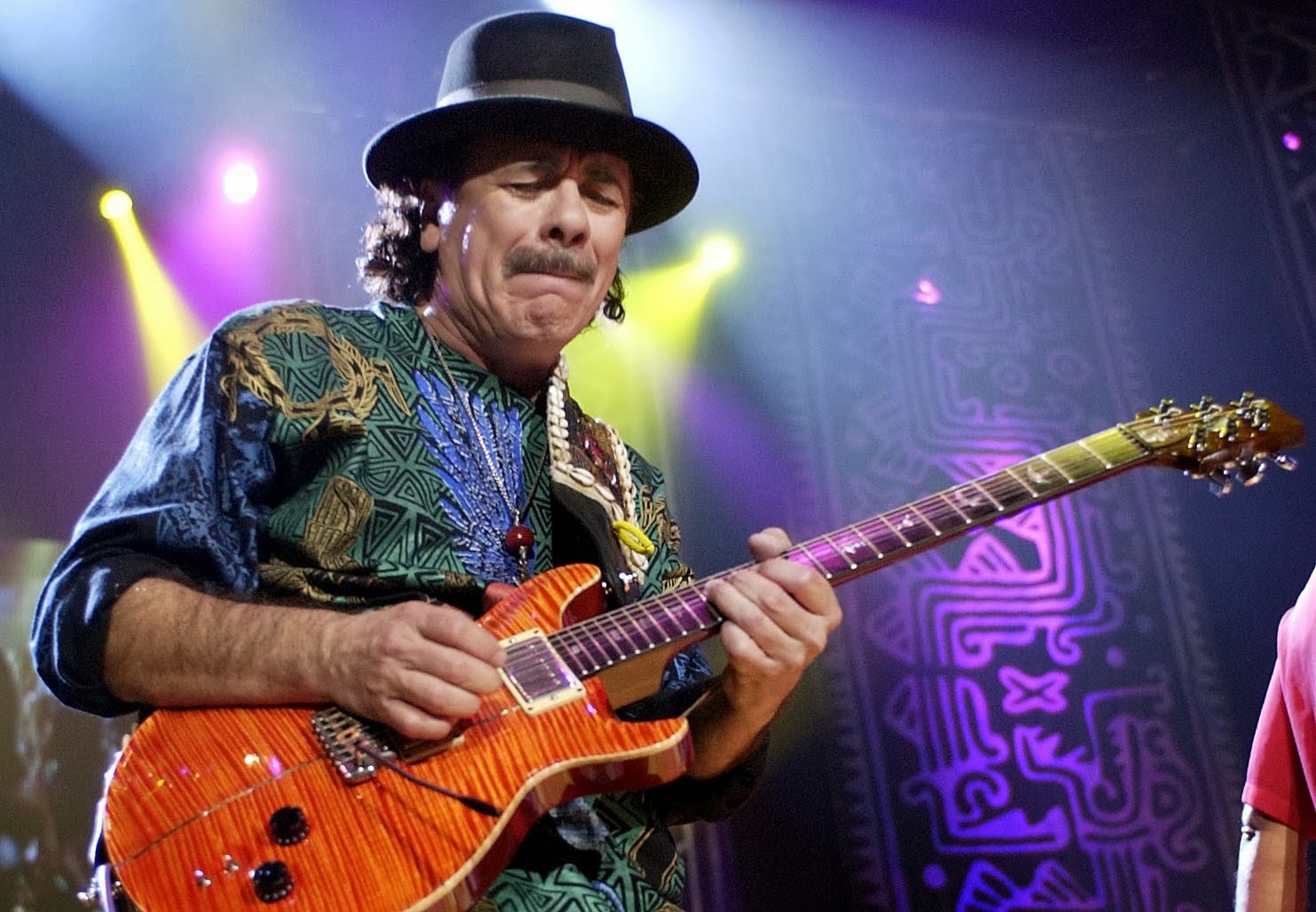
Stay connected